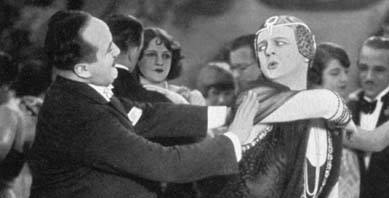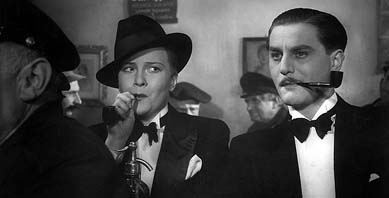Gender Roles in Weimar Comedy
"But I'm a man!" says Jack Lemmon in drag at the end of Billy Wilder's Hollywood classic "Some Like it Hot". He tears off his wig to prove it to his admirer, and his admirer tersely responds: "Nobody’s perfect!" Sexual identity, the attribution of masculinity or femininity, has always been a central, controversial, and often open question in cinema. From the beginning, film as the illusion of moving pictures has had to do with this most basic of distinctions, which is rendered first through appearance and perception. "When you meet a human being", wrote Sigmund Freud, "the first distinction you make is male or female — and you are accustomed to make the distinction with unhesitating certainty." Calling this seeming certainty into question is the first principle of travesty. Cross-dressing — donning the clothing of the other sex — enjoyed considerable popularity in Weimar Era film comedies. Examples of it include Ossie Oswalda as a chauffeur in "Amor am Steuer" (Love at the Wheel, 1921), Reinhold Schünzel's masquerade as a sophisticated nightclub patroness in "Der Himmel auf Erden" (Heaven on Earth, 1926), Elisabeth Bergner in a trousers role in "Doña Juana" (1927), Max Hansen’s performance as a female singer in "Die – oder keine" (Her — Or Nobody, 1932), and Fritz Schulz's stage travesty in "Drei Tage Mittelarrest" (Three Days Arrest, 1930), when he plays a soldier playing a soldier's bride.

On the one hand, this playing with gender roles was based on a theatrical tradition that was having a similar high phase at the time. Travesty roles were extremely popular on the stage, from the respective classics of William Shakespeare to Brandon Thomas's hit play "Charleys Tante". And with their drag numbers, Wilhelm Bendow and Hubert von Meyerinck were the darlings of cabaret audiences in the 1920s. On the other hand, there was also the ongoing cinematic tradition. In the Wilhelmine period, the play with gender roles (often with women dressing as men) was developed in films like "Es wär so schön gewesen" (It Would Have Been Wonderful, 1910) and "Der Sieg des Hosenrocks" (The Triumph of the Culottes, 1911), in Ernst Lubitsch's "Ich möchte kein Mann sein" (I Don’t Want to be a Man, 1918), and in "Aus eines Mannes Mädchenzeit" (From the Girlhood of a Man, 1912), which has Wilhelm Bendow in drag as a servant girl. Film historians differ widely in their interpretations of these early forms. Thomas Brandlmeier, for instance, understands "Aus eines Mannes Mädchenzeit" as the exception to a regressive rule: "The model of travesty in German cinema has never been that of seductive deception, but of ridiculing the 'false' sex." Heide Schlüpmann by contrast emphasizes the importance of film reception for "the play of male and female roles": "The significance of female audiences for the Wilhelmine period, as opposed to the Weimar era, cannot be ignored."

One happy moment for Weimar-era cross-dressing was Richard Eichberg’s "Der Fürst von Pappenheim" (The Masked Mannequin, 1927), in which Curt Bois carries a fashion show as a runway model, while a tailcoated Mona Maris plays the emcee. When her likewise tuxedoed fiancé shows up and she kisses him in view of her unsuspecting father, all the latter says, with a kindly wink of the eye, is: "I may be old-fashioned, but I still prefer to kiss a woman's lips." Reinhold Schünzel's hit comedy "Viktor und Viktoria" (1933) provided a no less modern and liberal treatment of gender roles and sexuality. In this Third Reich holdover from the Weimar era, the vacillation of lead actress Renate Müller between male and female generates the story. The film is a typical example of Reinhold Schünze's easy handling of prejudices and stereotypes, and at the same time a pinnacle of his work. As film historian Wolfgang Theis points out: "No other gay director had the guts to blur so uninhibitedly the dividing line between homosexuality and heterosexuality as did Schünzel in 'Viktor und Viktoria'."